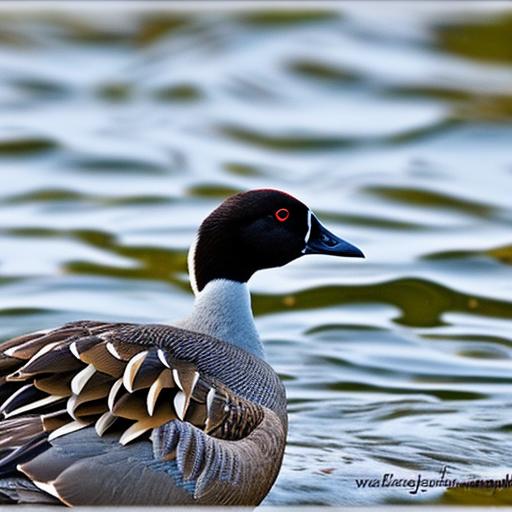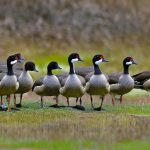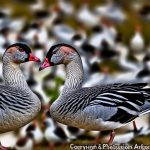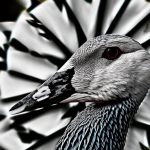Canadian geese, also known as Canada geese, are large waterfowl native to North America. They are known for their distinctive black heads, white cheeks, and long black necks. Canadian geese are highly adaptable and can be found in a variety of habitats, including lakes, rivers, ponds, and even urban areas. They are social birds that often travel in large flocks and mate for life.
Understanding how to coexist with Canadian geese is important because they are a common sight in many areas and can sometimes cause conflicts with humans. By learning about their behavior and implementing effective control methods, we can ensure a safe and harmonious environment for both humans and wildlife.
Key Takeaways
- Canadian geese can be found throughout North America and are known for their distinctive honking calls and V-shaped flying formations.
- While Canadian geese may seem harmless, they can pose a danger to humans and other wildlife, especially in areas where they have become overpopulated.
- There are legal restrictions on how Canadian geese can be controlled, and non-lethal methods such as habitat modification and deterrents are often preferred.
- Creating a safe environment for both humans and wildlife involves identifying Canadian geese habitats and behaviors, implementing effective deterrents, and maintaining a clean and healthy environment.
- Educating the community on Canadian geese control and seeking professional assistance can help ensure that these birds are managed in a humane and effective manner.
Understanding the Dangers of Canadian Geese
While Canadian geese may seem harmless, there are several dangers associated with their presence. One of the main concerns is the health risks associated with their droppings. Canadian geese produce a large amount of feces, which can contain harmful bacteria such as E. coli and Salmonella. These bacteria can contaminate water sources and pose a risk to humans and pets.
Another danger is the aggressive behavior that Canadian geese may exhibit towards humans and pets. During nesting season, which typically occurs from March to June, geese become more territorial and protective of their nests. They may hiss, honk, or even charge at perceived threats. This can be particularly dangerous for small children or pets who may unknowingly approach a nesting site.
Canadian geese can also cause damage to property and crops. Their feeding habits can result in the destruction of lawns, golf courses, and agricultural fields. They may also cause damage to buildings by nesting on rooftops or in chimneys. These issues can be costly to repair and can create additional conflicts between humans and geese.
Legal Restrictions on Canadian Geese Control
It is important to note that Canadian geese are protected under federal and state laws. The Migratory Bird Treaty Act of 1918 prohibits the hunting, capturing, or killing of migratory birds, including Canadian geese, without proper permits. Additionally, many states have their own regulations in place to protect these birds.
To control Canadian geese populations, it is necessary to obtain the necessary permits and follow the guidelines set forth by federal and state agencies. These permits may allow for the use of non-lethal methods such as habitat modification, harassment techniques, or egg addling (rendering eggs non-viable). It is important to consult with local wildlife agencies or professionals to ensure compliance with the law.
The Importance of Non-Lethal Methods for Canadian Geese Control
When it comes to controlling Canadian geese populations, non-lethal methods are not only more humane but also more effective in the long run. Lethal methods, such as hunting or culling, may temporarily reduce the population but often result in a rebound effect where the remaining geese reproduce at a higher rate to compensate for the loss.
Non-lethal methods for controlling Canadian geese populations include habitat modification, harassment techniques, and egg addling. Habitat modification involves altering the environment to make it less attractive to geese, such as installing barriers or removing food sources. Harassment techniques involve using noise makers, visual cues, or trained dogs to deter geese from an area. Egg addling involves shaking or coating eggs with oil to prevent them from hatching.
These non-lethal methods not only help manage Canadian geese populations but also benefit other wildlife species. By creating a safe and healthy environment for all species, we can promote biodiversity and maintain ecological balance.
Creating a Safe Environment for Humans and Wildlife
To create a safe environment for both humans and wildlife, it is important to maintain a clean and healthy environment. This includes proper waste disposal to prevent the accumulation of food sources that attract geese. It is also important to regularly clean up areas where geese congregate, such as parks or golf courses, to reduce the risk of disease transmission.
Encouraging natural predators, such as foxes or coyotes, can also help control Canadian geese populations. These predators naturally prey on geese and can help keep their numbers in check. However, it is important to note that introducing predators should be done carefully and in consultation with local wildlife agencies to ensure the safety of both humans and wildlife.
Identifying Canadian Geese Habitats and Behaviors

To effectively control Canadian geese populations, it is important to understand their habitats and behaviors. Canadian geese are primarily waterfowl and are often found near bodies of water such as lakes, rivers, or ponds. They prefer open areas with short grass where they can easily spot predators.
During the breeding season, Canadian geese become more territorial and may establish nesting sites near water sources. They typically build nests on the ground, using grasses and other vegetation. It is important to identify these nesting sites and take appropriate measures to deter geese from nesting in unwanted areas.
Understanding their patterns and behaviors can help in implementing effective control methods. For example, using noise makers or visual cues near nesting sites can discourage geese from settling in those areas. By disrupting their patterns and making the environment less attractive, we can reduce conflicts between humans and geese.
Implementing Effective Deterrents to Keep Canadian Geese Away
There are various deterrents that can be used to keep Canadian geese away from unwanted areas. Noise makers, such as propane cannons or ultrasonic devices, can be effective in scaring geese away. Visual cues, such as scarecrows or reflective tape, can also be used to create a sense of danger and deter geese from an area.
It is important to rotate deterrents regularly to prevent habituation. Geese can become accustomed to certain deterrents if they are not changed frequently. By rotating different types of deterrents, we can maintain their effectiveness and keep geese from becoming comfortable in a particular area.
Maintaining a Clean and Healthy Environment to Discourage Canadian Geese
To discourage Canadian geese from congregating in an area, it is important to maintain a clean and healthy environment. This includes proper waste disposal to prevent the accumulation of food sources that attract geese. It is also important to regularly clean up areas where geese congregate, such as parks or golf courses, to reduce the risk of disease transmission.
Landscaping practices can also play a role in discouraging geese. Planting tall grasses or shrubs near water sources can create barriers that make it difficult for geese to access nesting sites. Additionally, reducing the amount of open grassy areas can make an environment less attractive to geese.
Educating the Community on Canadian Geese Control
Educating the community on how to coexist with Canadian geese is crucial for effective control. By raising awareness about the dangers associated with geese and providing information on non-lethal control methods, we can empower individuals to take action and implement effective strategies.
Tips for educating neighbors and community members include distributing informational brochures or hosting workshops on Canadian geese control. It is important to emphasize the importance of following legal restrictions and obtaining necessary permits for control methods. By working together as a community, we can create a safer and more harmonious environment for both humans and wildlife.
Seeking Professional Assistance for Canadian Geese Management
In some cases, it may be necessary to seek professional assistance for Canadian geese management. Licensed and experienced professionals have the knowledge and expertise to implement humane and effective control methods while ensuring compliance with federal and state laws.
Professional assistance may be required in situations where geese populations are particularly large or where other control methods have been ineffective. These professionals can assess the situation, develop a management plan, and implement appropriate control measures.
In conclusion, understanding how to coexist with Canadian geese is important for the safety of both humans and wildlife. By understanding their behavior and implementing effective control methods, we can create a harmonious environment where conflicts are minimized. Non-lethal methods are not only more humane but also more effective in the long run. By maintaining a clean and healthy environment, encouraging natural predators, and educating the community, we can ensure a safe and sustainable future for both humans and wildlife.
If you’re looking for effective ways to keep Canadian geese off your lake shore, you might also be interested in learning about poultry management techniques. Poultry Wizard offers a variety of resources, including an article on how to rent a chicken coop (source). This can be a great solution for those who want to enjoy the benefits of having chickens without the long-term commitment. Additionally, if you’re curious about breeding chickens, Poultry Wizard has an informative article on how long it takes for chicken eggs to hatch naturally (source). Lastly, if you’re considering keeping quail as an alternative option, you can find valuable insights on what vegetables quails eat (source). These resources can provide you with useful knowledge and strategies for managing various types of poultry.
FAQs
What are Canadian geese?
Canadian geese are a species of waterfowl that are native to North America. They are known for their distinctive black heads and necks, white cheeks, and brown bodies.
Why do Canadian geese flock to lake shores?
Canadian geese are attracted to lake shores because they provide a source of food and water. They also offer a safe place for the geese to rest and nest.
What problems can Canadian geese cause on lake shores?
Canadian geese can cause a number of problems on lake shores, including damage to property, aggressive behavior towards humans and other animals, and the spread of disease through their droppings.
How can I keep Canadian geese off my lake shore?
There are several methods for keeping Canadian geese off your lake shore, including using decoys, installing fencing or netting, using noise deterrents, and removing food sources.
Is it legal to harm Canadian geese?
No, it is illegal to harm Canadian geese under the Migratory Bird Treaty Act. However, there are legal methods for controlling their populations, such as egg addling and relocation.
Meet Walter, the feathered-friend fanatic of Florida! Nestled in the sunshine state, Walter struts through life with his feathered companions, clucking his way to happiness. With a coop that’s fancier than a five-star hotel, he’s the Don Juan of the chicken world. When he’s not teaching his hens to do the cha-cha, you’ll find him in a heated debate with his prized rooster, Sir Clucks-a-Lot. Walter’s poultry passion is no yolk; he’s the sunny-side-up guy you never knew you needed in your flock of friends!







